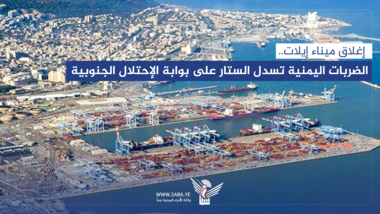Sana'a - Saba:
The port of Eilat, historically known as the Port of Umm al-Rashrash, is breathing its last breaths under the weight of a sharp decline in commercial activity and a rapid decline in revenues, this is a scene where economic and field data intertwine to chart the end of a facility that has long represented a strategic artery for Israeli trade in the Red Sea.
Under the pressure of accumulating collapse, the port's administration announced its complete closure effective Sunday, July 20, 2025. Most of its operations had ceased and its bank accounts were frozen due to accumulating debts, this decision was the result of a long history of operational deficits and a loss of economic viability, at a time when Yemeni strikes were deepening the imbalance and accelerating the collapse without the need for direct confrontation or a field presence.
Signs of decline began in early 2024, with a significant decline in inbound and outbound ship traffic, these indicators peaked in the first half of 2025, with only six ships registered, compared to 134 in 2023, this led to a complete contraction in port activity and the disruption of its associated supply chains.
This decline was accompanied by a sharp collapse in revenues, which fell from NIS 212 million in 2023 to NIS 42 million in 2024, this led to an inability to meet operational obligations, the suspension of wages and essential maintenance, and the imposition of a seizure on the port's bank accounts by the Eilat Municipality.
The port's closure represents a critical blow to Israel's automotive sector, the port previously received nearly half of the entity's vehicle imports, handling approximately two million tons of goods annually, in addition to more than 50,000 commercial containers with a market value estimated at $6 billion, this disruption disrupts a critical supply chain and undermines one of the most vital import routes in the south.
The impact extended to the export sector, with phosphate and potash exports through the port suffering an estimated $4.1 billion in annual profits, these exports, which were directed to Asian markets via Umm al-Rashrash Port, represented a double loss in terms of income and external connectivity.
The administrative collapse forced hundreds of workers to leave their jobs following mass layoffs implemented by the port administration as part of comprehensive downsizing measures, including the suspension of service departments and the closure of maritime workshops, this sparked a wave of discontent within the city's labor sectors and heightened social tensions.
This situation contributed to a more than 25 percent increase in shipping costs due to the rerouting of ships to alternative ports further north, leading to disruptions in arrival times, increased supply costs, and impacted the stability of commodity prices amid a commercial environment facing increasing domestic pressures.
The city of Eilat itself has experienced a severe economic contraction, losing approximately 15 percent of its annual income due to the suspension of port-related services, primarily the fisheries sector, maintenance, land transportation, and associated tourism, this has transformed the city into an economic burden rather than a strategic outlet.
Observers believe that the Yemeni targeting of the port of Umm al-Rashrash (Eilat) has shifted the battle deeper into the Israeli economic system. Vital facilities are no longer immune to direct impact, given the expanding scope and increased accuracy of attacks, this has altered the rules of engagement and redistributed the tools of regional pressure.
The Yemeni Armed Forces last targeted the port on July 16, 2025, with three drones hitting operational sites around the port and military facilities in the Negev region, this prompted the administration to take the decision to shut it down after repeated failures to continue.
Experts point out that the successive impacts on the port since 2023 have created a new reality in the Red Sea, in which Sana'a emerges as an influential force in determining trade routes and shipping routes, using low-cost, high-precision tools that produce strategic results without direct escalation.
The port today stands out as a case in point, reflecting the significant decline in trade flow under the pressure of smart targeting, controlling or closing the sea did not require military force, but rather relied on a policy of systematic disruption, effectively removing the port from the international transport equation.
These shifts have reshuffled maritime investment priorities in Israel, as the southern ports have become both a financial and security burden, this has prompted a review of maritime connectivity plans and increased reliance on inland ports, despite their high costs and the complexity of their supply lines compared to Eilat's geographical location.
The effects of the closure extend to two interconnected dimensions: economic and security, the port's decline is no longer understood as a limited sectoral loss, but rather as a sign of a shifting balance of influence in the Red Sea, with the rise of precise and effective pressure tools that are redistributing control away from traditional power.
What happened to the Umm al-Rashrash port sends a multifaceted message, most notably that the cost of keeping ports open in an active threat environment has become beyond the occupation's ability to bear, especially with the multiplicity of fronts and the increasing financial and popular pressure on internal decision-making institutions.
The new map of trade corridors reveals the direct consequences of this closure, as companies reassess their approach to Israeli ports and shift to more stable alternative routes, this limits the attractiveness of maritime investment in the south and gives Sana'a an increasingly influential position in regional trade decisions.
The closure of the port of Eilat represents the culmination of a profound shift in the balance of maritime influence in the region, Yemen's ability to impose a strategic cost has emerged outside of traditional equations, successfully putting a vital port out of service through a series of pressure attacks and precision strikes, the impact of this closure is not limited to its geographic scope; rather, it opens a new phase in deterrence and control calculations, redrawing the map of navigation and trade across the Red Sea.
M.M

| more of (Reports) |




